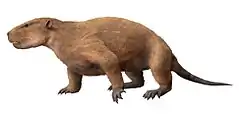| Ptilodontidae Temporal range: | |
|---|---|
 | |
| Skull of Ptilodus | |
| Scientific classification | |
| Domain: | Eukaryota |
| Kingdom: | Animalia |
| Phylum: | Chordata |
| Class: | Mammalia |
| Order: | †Multituberculata |
| Superfamily: | †Ptilodontoidea |
| Family: | †Ptilodontidae Cope, 1887 |
| Genera | |
Ptilodontidae is a family of primitive mammals within the extinct order Multituberculata. Representatives are known from the Upper Cretaceous and Paleocene of North America.
The Ptilodontidae family was originally named Ptilodontinae and classified as a subfamily by Edward Drinker Cope in 1887. It was amended by Gregory and Simpson in 1926 to its current status.
In addition, Cope mistakenly classified the Ptilodus genus as a marsupial. He originally named it Chirox, and placed it in the new family Chirogidae in 1887. Since it has been reclassified, and Chirogidae is now officially a synonym of Ptilodontidae.
One of the most outstanding features of this family of squirrel-like, arboreal mammals, was the peculiar shape of their last lower premolar. It was larger and more elongated than its neighbours, and its occlusive surface was formed into a serrated slicing blade. Most likely this tooth was used for crushing and opening seeds and nuts, but it is believed that the ptilodonts, like most small multituberculates, supplemented their diet with insects, worms, and fruits. [1]
Notes
- ↑ Augustí 2002, p 4
References
- Agustí, Jordi; Antón, Mauricio (2002). Mammoths, Sabertooths, and Hominids: 65 Millions Years of Mammalian Evolution in Europe. New York: Columbia University Press. ISBN 0-231-11640-3.
- Cope, Edward Drinker (1887). "The marsupial genus Chirox". American Naturalist (21): 566–567.
- Dykes, Trevor (2009). "'Mesozoic Mammals'; Ptilodontoidea, an internet directory". Archived from the original on 2009-12-28. Retrieved January 9, 2010. (Much of the information in this article has been derived from this site.)
- Kielan-Jaworowska, Z.; Hurum; J.H. (2001). "Phylogeny and Systematics of multituberculate mammals" (PDF). Palaeontology. 44 (3): 389–429. doi:10.1111/1475-4983.00185. S2CID 83592270.

